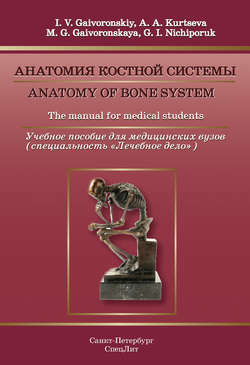Читать книгу Anatomy of bone system. The manual for medical students / Анатомия костной системы. Учебное пособие для медицинских вузов - Г. И. Ничипорук - Страница 5
1. GENERAL ОSTEOLOGY
1.1. Bone as an Organ
ОглавлениеBone, os, is an organ, which is a component of the musculoskeletal system. It hаs a typical form and structure, specific architectonics of vessels and nerves, it is constructed mainly from osseous tissue covered with periosteum on the outside; periosteum containing inside bone marrow, medulla osseum.
Each bone has a certain shape, size and location in the human body. The conditions of bone development and functional loads which bones are subjected to in ontogenesis influence the morphogenesis of bones. Each bone has a certain number of blood supply sources (arteries), which have specific extra- and intraorganic architectonics. Nervous structures of bones also have such features.
The bone is coated with periosteum on the outside, except the surfaces and places where articular cartilages are locted, and where muscles, tendons and ligaments are attached to the bone. The periosteum separates the bone from its surrounding tissues. It is a thin sheath of dense connective tissue which contains blood and lymphatic vessels and nerves. The nerves penetrate into the bone tissue from the periosteum.
The periosteum, periosteum, plays a major role in bone growth at thickness and in its nutrition. The osseous tissue is formed in the inner osteogenic layer of the periosteum. A bone lacking periosteum becomes inviable and necrotizes. The periosteum has a rich nerve supply, therefore it is very sensitive. During surgical operations, doctors try to maximally preserve the periosteum because of its very important role in reparative processes.
Almost all bones (except for most of the skull bones) have articular surfaces for junction with other bones. The articular surfaces are covered not with periosteum, but with articular cartilage, cartilago articularis. The articular cartilage has a specific, nonuniform structure: its superficial layer resembles a hyaline cartilage, the deep layer is fibrous.
The majority of bones have bone marrow inside – in spaces between lamellae of the spongy bone or in the medullary cavity, cavitas medullaris. The medullary cavity is covered inside with a specific sheath which is termed endosteum – endosteum. The endosteum, as well as the periosteum, plays a great role in metabolic processes in bones.
Bones of fetuses and newborns contain only red (haematogenic) bone marrow, medulla ossea rubra. It is a homogenous red color mass, rich in reticulate tissue, blood corpuscles and blood vessels. The total amount of red bone marrow is about 1500 cm3. In an adult, red bone marrow is partially substituted with yellow bone marrow, medulla osseum flava, which is mainly composed of adipose cells. Red bone marrow is substituted with yellow bone marrow only within medullar cavities.
